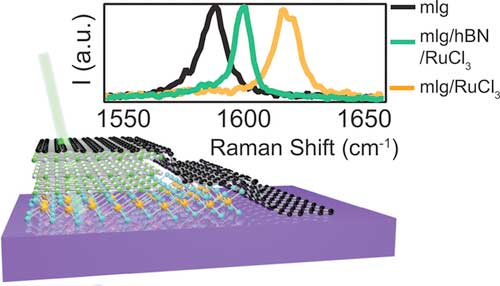| Jan 14, 2021 |
New way to control electrical charge in 2D materials: Put a flake on it
(Nanowerk News) Physicists at Washington University in St. Louis have discovered how to locally add electrical charge to an atomically thin graphene device by layering flakes of another thin material, alpha-RuCl3, on top of it.
|
|
A paper published in the journal Nano Letters ("Modulation Doping via a Two-Dimensional Atomic Crystalline Acceptor") describes the charge transfer process in detail. Gaining control of the flow of electrical current through atomically thin materials is important to potential future applications in photovoltaics or computing.
|
 |
| A layered device transfers electric charge. (© Nano Letters)
|
|
“In my field, where we study van der Waals heterostructures made by custom-stacking atomically thin materials together, we typically control charge by applying electric fields to the devices,” said Erik Henriksen, assistant professor of physics in Arts & Sciences and corresponding author of the new study, along with Ken Burch at Boston College. “But here it now appears we can just add layers of alpha-RuCl3. It soaks up a fixed amount of electrons, allowing us to make ‘permanent’ charge transfers that don’t require the external electric field.”
|
|
Jesse Balgley, a graduate student in Henriksen's laboratory at Washington University, is second author of the study. Li Yang, professor of physics, and his graduate student Xiaobo Lu, also both at Washington University, helped with computational work and calculations, and are also co-authors.
|
|
Physicists who study condensed matter are intrigued by alpha-RuCl3 because they would like to exploit certain of its antiferromagnetic properties for quantum spin liquids.
|
|
In this new study, the scientists report that alpha-RuCl3 is able to transfer charge to several different types of materials — not just graphene, Henriksen’s personal favorite.
|
|
They also found that they only needed to place a single layer of alpha-RuCl3 on top of their devices to create and transfer charge. The process still works, even if the scientists slip a thin sheet of an electrically insulating material between the alpha-RuCl3 and the graphene.
|
|
“We can control how much charge flows in by varying the thickness of the insulator,” Henriksen said. “Also, we are able to physically and spatially separate the source of charge from where it goes — this is called modulation doping.”
|
|
Adding charge to a quantum spin liquid is one mechanism thought to underlie the physics of high-temperature superconductivity.
|
|
“Anytime you do this, it could get exciting,” Henriksen said. “And usually you have to add atoms to bulk materials, which causes lots of disorder. But here, the charge flows right in, no need to change the chemical structure, so it’s a ‘clean’ way to add charge.”
|

